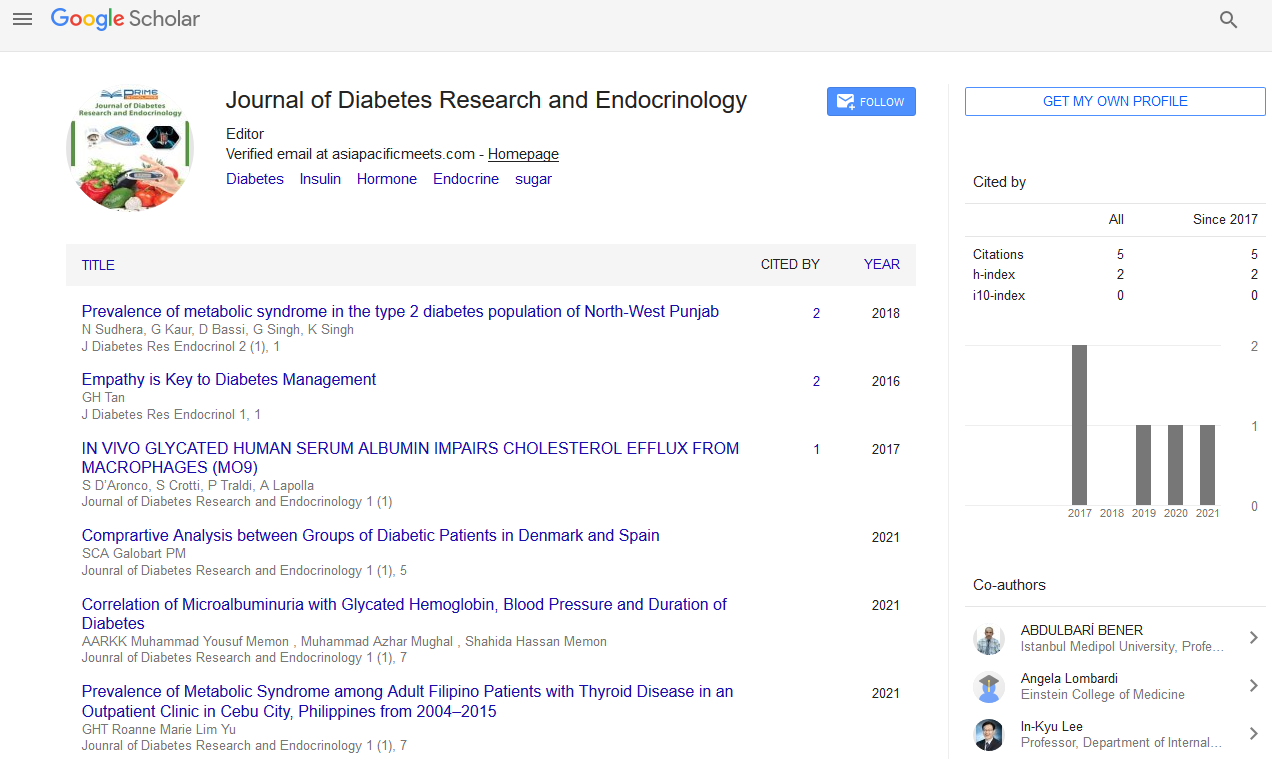Commentary - (2024) Volume 8, Issue 1
Gut Microbiome and Its Role in Type 2 Diabetes
George Thompson*
Department of Endocrinology, Buckingham University, UK
*Correspondence:
George Thompson,
Department of Endocrinology, Buckingham University,
UK,
Email:
Received: 28-Feb-2024, Manuscript No. IPJDRE-24-20060;
Editor assigned: 01-Mar-2024, Pre QC No. IPJDRE-24-20060 (PQ);
Reviewed: 15-Mar-2024, QC No. IPJDRE-24-20060;
Revised: 20-Mar-2024, Manuscript No. IPJDRE-24-20060 (R);
Published:
27-Mar-2024, DOI: 10.36648/ipjdre.08.02.04
Description
Type 2 diabetes (T2D) is a complex metabolic disorder
characterized by insulin resistance and impaired glucose
regulation. While genetic predisposition and lifestyle factors such
as diet and physical activity are well-established contributors,
recent research has illuminated the significant role of the gut
microbiome in the pathogenesis and management of T2D.
The gut microbiome, comprising trillions of microorganisms
residing in the human gastrointestinal tract, plays a crucial
role in metabolic health, immune function, and inflammation.
Understanding its impact on T2D opens new avenues for potential
therapeutic strategies. The human gut microbiome consists of
bacteria, viruses, fungi, and other microorganisms that live
symbiotically within the digestive tract. These microorganisms
aid in digestion, synthesize essential vitamins, and protect
against pathogens. The composition of the gut microbiome
is influenced by various factors, including genetics, diet, age,
and antibiotic use. The gut microbiome influences metabolic
health through several mechanisms Certain gut bacteria can
extract more calories from food, contributing to increased
energy intake and potentially leading to obesity, a major risk
factor for T2D. Fermentation of dietary fibres by gut bacteria
produces SCFAs, such as butyrate, propionate, and acetate,
which have anti-inflammatory properties and improve insulin
sensitivity. Symbiosis, an imbalance in the gut microbiome, can
lead to increased intestinal permeability, allowing endotoxins
like lipopolysaccharides (LPS) to enter the bloodstream. This
triggers systemic inflammation and insulin resistance. Gut
bacteria modify bile acids, which play a role in lipid metabolism
and glucose homeostasis. Altered bile acid profiles can impact
insulin sensitivity and glucose metabolism. Several studies have
shown that individuals with T2D have distinct gut microbiome
profiles compared to healthy individuals. Key findings include
T2D patients often exhibit decreased gut microbiome diversity,
which is associated with metabolic dysfunction. Increased
levels of certain bacterial strains, such as Bactericides and
Clostridium, and decreased levels of others, like Faecal
bacterium prausnitzii, have been observed in T2D patients.
Faecal bacterium prausnitzii is known for its anti-inflammatory
properties and its reduction may contribute to inflammation
and insulin resistance. Alterations in microbial metabolites,
such as reduced SCFA production, are commonly seen in T2D,
suggesting a link between these metabolites and glucose
regulation. The connection between the gut microbiome and
T2D has prompted interest in microbiome-targeted therapies,
including Supplementing with beneficial bacteria strains may
help restore gut microbiome balance, improve gut barrier
function, and enhance insulin sensitivity. Certain probiotics
have shown promise in reducing blood glucose levels and
inflammation in T2D patients. These non-digestible food
ingredients stimulate the growth of beneficial bacteria in the
gut. Prebiotics, such as inulin and fructooligosaccharides, can
increase SCFA production and improve metabolic health. Diet
significantly impacts the gut microbiome. High-finer diets,
rich in fruits, vegetables, and whole grains, promote a healthy
microbiome and SCFA production, potentially improving insulin
sensitivity and glycaemic control. Although still in experimental
stages, FMT involves transferring focal bacteria from a healthy
donor to a recipient. Initial studies suggest that FMT can
improve insulin sensitivity in T2D patients, but more research is
needed to establish its efficacy and safety. The gut microbiome
plays a pivotal role in the development and progression of type
2 diabetes through its influence on metabolism, inflammation,
and insulin sensitivity. While traditional risk factors for T2D, such
as diet and genetics, remain crucial, the gut microbiome offers
a novel and promising avenue for therapeutic interventions.
Future research focused on understanding the intricate
interactions between the gut microbiome and host metabolism
will be essential in developing effective strategies for the
prevention and management of type 2 diabetes.
Acknowledgement
None.
Conflict Of Interest
The author’s declared that they have no conflict of interest.
Citation: Thompson G (2024) Gut Microbiome and its Role in Type 2 Diabetes. J Diab Res Endocrinol. 8:04.
Copyright: © 2024 Thompson G. This is an open-access article distributed under the terms of the Creative Commons Attribution License, which permits unrestricted use, distribution, and reproduction in any medium, provided the original author and source are credited.

